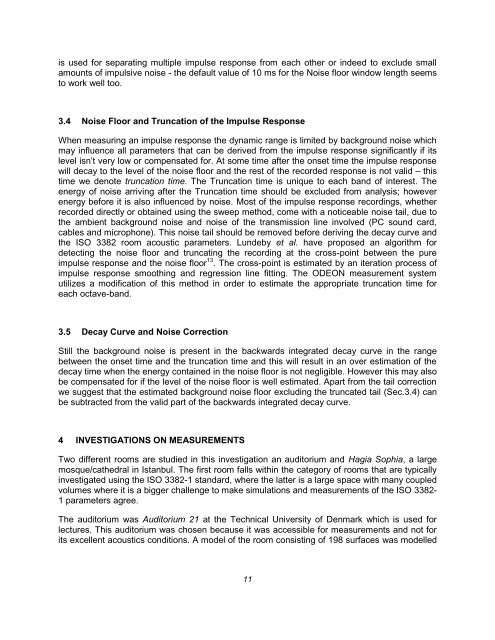paper - Odeon
paper - Odeon
paper - Odeon
Create successful ePaper yourself
Turn your PDF publications into a flip-book with our unique Google optimized e-Paper software.
is used for separating multiple impulse response from each other or indeed to exclude small<br />
amounts of impulsive noise - the default value of 10 ms for the Noise floor window length seems<br />
to work well too.<br />
3.4 Noise Floor and Truncation of the Impulse Response<br />
When measuring an impulse response the dynamic range is limited by background noise which<br />
may influence all parameters that can be derived from the impulse response significantly if its<br />
level isn’t very low or compensated for. At some time after the onset time the impulse response<br />
will decay to the level of the noise floor and the rest of the recorded response is not valid – this<br />
time we denote truncation time. The Truncation time is unique to each band of interest. The<br />
energy of noise arriving after the Truncation time should be excluded from analysis; however<br />
energy before it is also influenced by noise. Most of the impulse response recordings, whether<br />
recorded directly or obtained using the sweep method, come with a noticeable noise tail, due to<br />
the ambient background noise and noise of the transmission line involved (PC sound card,<br />
cables and microphone). This noise tail should be removed before deriving the decay curve and<br />
the ISO 3382 room acoustic parameters. Lundeby et al. have proposed an algorithm for<br />
detecting the noise floor and truncating the recording at the cross-point between the pure<br />
impulse response and the noise floor 13 . The cross-point is estimated by an iteration process of<br />
impulse response smoothing and regression line fitting. The ODEON measurement system<br />
utilizes a modification of this method in order to estimate the appropriate truncation time for<br />
each octave-band.<br />
3.5 Decay Curve and Noise Correction<br />
Still the background noise is present in the backwards integrated decay curve in the range<br />
between the onset time and the truncation time and this will result in an over estimation of the<br />
decay time when the energy contained in the noise floor is not negligible. However this may also<br />
be compensated for if the level of the noise floor is well estimated. Apart from the tail correction<br />
we suggest that the estimated background noise floor excluding the truncated tail (Sec.3.4) can<br />
be subtracted from the valid part of the backwards integrated decay curve.<br />
4 INVESTIGATIONS ON MEASUREMENTS<br />
Two different rooms are studied in this investigation an auditorium and Hagia Sophia, a large<br />
mosque/cathedral in Istanbul. The first room falls within the category of rooms that are typically<br />
investigated using the ISO 3382-1 standard, where the latter is a large space with many coupled<br />
volumes where it is a bigger challenge to make simulations and measurements of the ISO 3382-<br />
1 parameters agree.<br />
The auditorium was Auditorium 21 at the Technical University of Denmark which is used for<br />
lectures. This auditorium was chosen because it was accessible for measurements and not for<br />
its excellent acoustics conditions. A model of the room consisting of 198 surfaces was modelled<br />
11
















